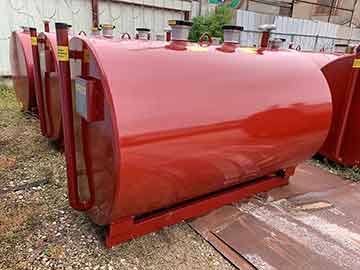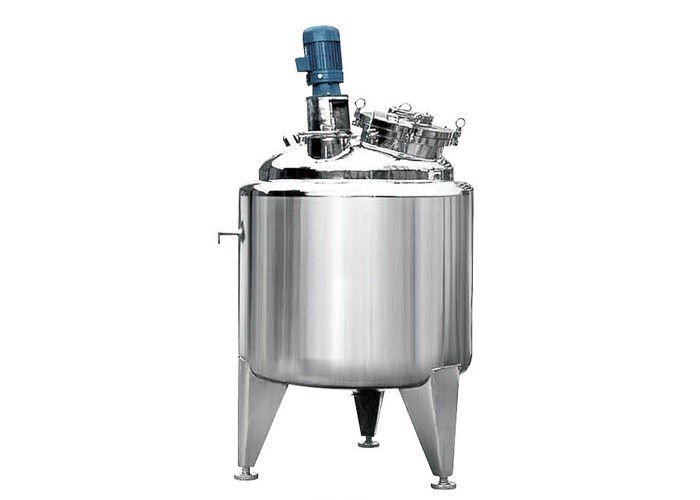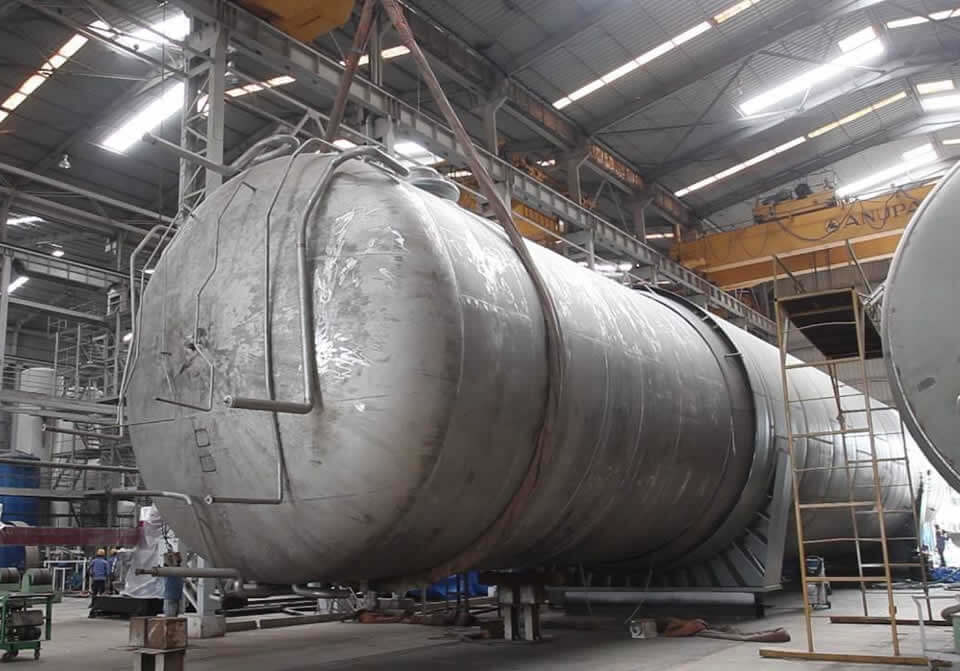How Oil & Gas Storage Tank Fabrication is adapting to strict environmental regulations
The Future of Storage Tank Manufacturing: Trends and Technologies to View
The storage tank manufacturing sector gets on the cusp of a pivotal evolution, driven by arising fads in clever materials, automation, and sustainability. As industries significantly focus on environmental responsibility, innovations such as environmentally friendly compounds and IoT-driven surveillance systems are reshaping functional standards. Furthermore, the expanding demand for customization and modular designs suggests a change in the direction of more adaptable manufacturing practices. Understanding these fads not just highlights the obstacles ahead but also reveals opportunities that might redefine the landscape of storage tank production in the coming years. What implications might these innovations hold for market stakeholders?
Developments in Smart Products
In the last few years, the storage tank manufacturing market has actually witnessed a substantial uptick in the adoption of clever products, transforming layout and performance. Smart products, which can respond dynamically to environmental changes, have actually enabled manufacturers to produce storage tanks that are not only much more resilient however also extra effective in their operational capacities.
One notable development is the assimilation of shape memory alloys and polymers that can adapt to differing stress and temperatures. This adaptability boosts the architectural honesty of tanks, reducing the danger of leaks and failures (Texas Oil & Gas Storage Tank Fabrication Authority). In addition, these materials usually exhibit self-healing properties, which even more prolongs the life-span of tank, decreasing maintenance costs and improving safety
The consolidation of sensors within smart materials enables for real-time monitoring of tank problems, providing critical information that helps in anticipating upkeep and risk management. This data-driven method not only boosts operational efficiency however also straightens with environmental sustainability goals by maximizing source use and preventing spills.
Surge of Automation Technologies
The surge of automation technologies is changing storage tank manufacturing by incorporating robotics into production processes, boosting performance and precision. Additionally, the release of clever sensing units makes it possible for real-time tracking, making certain quality control and security criteria are satisfied. AI-driven process optimization additionally improves operations, decreasing prices and improving overall performance in the market.
Robotics Combination in Manufacturing
Robotics integration is revolutionizing the manufacturing landscape, specifically in the storage tank industry. As manufacturers venture for enhanced effectiveness and precision, robotics modern technologies are ending up being necessary devices for streamlining production procedures. Automated systems can performing repetitive tasks with greater rate and accuracy than human labor, reducing the probability of errors and enhancing total product high quality.
One of the key benefits of robotic integration is the capacity to enhance operations. Automated robot arms can handle heavy materials, weld components, and conduct inspections, which decreases physical strain on employees and reduces downtime. This change not only improves security yet also permits human employees to concentrate on even more complicated and value-added jobs.
Robotics can facilitate adaptable production, enabling companies to adapt quickly to transforming market needs. Advanced shows permits robotics to conveniently switch over in between different tasks and products, which is specifically helpful in a sector where personalization is increasingly desired
As robotics technology remains to advance, manufacturers can expect enhanced capacities, including enhanced maker finding out formulas and increased truth applications, additionally driving performance in storage tank production and setting brand-new criteria for the market.
Smart Sensors Implementation

The data gathered from these sensing units can be leveraged to optimize the supply chain, guaranteeing that products are available when required while minimizing waste. This degree of insight enables manufacturers to respond promptly to changing conditions and customer needs, boosting overall performance.
In addition, smart sensing units contribute to enhanced regulative conformity by continuously keeping track of ecological aspects and making sure adherence to safety and security criteria. As the sector progresses in the direction of even more sustainable techniques, the ability to monitor discharges and resource intake in real-time is important.
AI-Driven Process Optimization
Manufacturers in the storage tank industry are significantly using the power of AI-driven procedure optimization to enhance functional efficiency and decision-making capabilities. By incorporating advanced algorithms and maker knowing techniques, business can examine vast amounts of data generated throughout the manufacturing process. This data-driven method enables real-time tracking of manufacturing metrics, causing more educated choices and prompt treatments.
AI innovations assist in anticipating upkeep, allowing manufacturers to prepare for equipment failures before they occur, consequently decreasing downtime and upkeep costs. Furthermore, these systems can optimize resource allowance by examining production patterns and readjusting operations, ensuring that materials and labor are utilized successfully.
AI-driven optimization enhances high quality control by determining prospective issues throughout the manufacturing procedure. Automated assessments powered by AI can quickly identify disparities, guaranteeing that only products meeting rigid top quality requirements progress with the manufacturing line.
As the storage tank industry proceeds to welcome automation, AI-driven process optimization attracts attention as a transformative force, driving innovation and competitiveness. By leveraging these innovations, manufacturers can not just simplify operations but also adjust swiftly to market demands, positioning themselves for lasting growth in a progressively intricate manufacturing landscape.
Focus on Sustainability Practices
As the storage tank manufacturing field evolves, a substantial emphasis is positioned on sustainability practices. This consists of the adoption of eco-friendly materials, the application of energy-efficient production processes, and the integration of round economic climate principles. By focusing on these efforts, manufacturers not only minimize their environmental influence but additionally enhance the long life and efficiency of their items.
Environment-friendly Products Fostering
Significantly, the storage tank production sector is embracing environmentally friendly materials as a basic facet of sustainability techniques. This shift is driven by enhanced ecological awareness and regulatory stress, prompting manufacturers to look for choices that decrease eco-friendly influence.
Recycled metals and biodegradable compounds are obtaining grip, providing both performance and reduced carbon footprints. As an example, making use of high-recycled-content steel not just decreases the demand for virgin products however likewise enhances the overall sustainability of the item lifecycle. Furthermore, manufacturers are checking out bio-based resins that provide longevity while being much less harmful to the setting.
The fostering of environmentally friendly coatings and coatings, which are complimentary from volatile natural compounds (VOCs), mirrors the industry's dedication to decreasing air contamination and promoting much healthier working conditions. These developments not only line up with global sustainability objectives but additionally fulfill the expanding market need for greener items.
The combination of eco-friendly materials in storage tank production is not merely a pattern; it stands for an aggressive technique in the direction of liable manufacturing that focuses on both environmental stewardship and economic stability, establishing a new standard for future developments in the industry.
Energy-efficient Manufacturing Processes
There is a growing acknowledgment within the storage tank manufacturing industry of the relevance of energy-efficient procedures as a necessary part of sustainable techniques. As the market faces increasing pressure to minimize its carbon footprint, manufacturers are carrying out ingenious innovations and methodologies targeted at minimizing energy intake throughout the production cycle.
One substantial trend is the adoption of innovative manufacturing strategies such as lean manufacturing and automation. These methods streamline procedures, minimize waste, and improve efficiency, while additionally decreasing energy use. Furthermore, the assimilation of eco-friendly power resources, such as solar and wind power, right into manufacturing centers is coming to be extra widespread, permitting companies to operate sustainably and decrease dependence on fossil fuels.
Furthermore, energy-efficient machinery and equipment are being prioritized in brand-new financial investments, as manufacturers look for to optimize their energy intake. The use of energy monitoring systems makes it possible for real-time tracking and analysis, assisting in constant improvement in energy efficiency.
Round Economic Situation Assimilation
A remarkable shift in the direction of round economic climate integration is changing sustainability practices within the storage tank manufacturing sector. This approach stresses the significance of resource effectiveness, waste decrease, and the recycling of materials throughout the manufacturing lifecycle. By embracing round principles, manufacturers are increasingly concentrated on designing containers that prioritize longevity, recyclability, and repairability.
As component of this adjustment, business are discovering ingenious products and production approaches that reduce ecological impact. The unification of recycled metals and plastics not only reduces the need for virgin resources however also reduces carbon emissions related to extraction and handling. Additionally, manufacturers are carrying out take-back schemes that assist in the repair and recycling of end-of-life tanks, consequently shutting the loop in the production cycle.
Cooperation among stakeholders, including vendors and consumers, is vital for promoting a round economy (Storage Tank Manufacturing). This collaboration makes it possible for the sharing of best practices and motivates the growth of lasting supply chains. Eventually, incorporating round economy concepts into storage tank production not only improves ecological stewardship yet additionally settings firms to satisfy developing governing requirements and customer assumptions for sustainability
Enhanced Safety And Security Procedures
In today's production landscape, enhanced security protocols have become critical for storage tank manufacturers. The industry deals with raising governing scrutiny and demands for higher safety and security criteria due to the prospective risks related to the storage of hazardous products. As a result, manufacturers are taking on a multifaceted strategy to enhance precaution throughout the manufacturing process.
One substantial advancement is the implementation of innovative threat evaluation tools that recognize prospective risks during the design and production stages. These tools help with positive measures to mitigate risks prior to they intensify into important problems. Furthermore, manufacturers are purchasing worker training programs that highlight safety techniques, ensuring that all employees are fluent in emergency treatments and devices handling.
Furthermore, there is an expanding emphasis on the use of premium materials and cutting-edge layouts that enhance architectural stability and decrease the probability of leakages or failings. Regular maintenance checks and strenuous testing procedures are additionally being integrated into the manufacturing lifecycle to assure compliance with security laws.
Integration of IoT Solutions

IoT tools assist in anticipating Texas Oil & Gas Storage Tank Fabrication Authority maintenance, which minimizes downtime and expands the life expectancy of storage tanks. By assessing information accumulated from sensing units, manufacturers can perform and predict possible failures maintenance tasks before essential problems emerge. This positive approach not only conserves costs however also ensures conformity with security regulations.
In addition, IoT combination supports far better stock management by giving exact, real-time data on kept materials. Texas Oil & Gas Storage Tank Fabrication Authority. This ability helps manufacturers enhance their supply chains, making certain that necessary sources are readily available when required, therefore boosting total efficiency
Furthermore, the implementation of IoT services allows boosted interaction in between tanks and centralized monitoring systems, simplifying procedures. As the storage tank production market continues to take on IoT technologies, we can anticipate significant improvements in safety and security protocols and operational efficiencies, ultimately resulting in even more durable production techniques.
Customization and Modular Layout
Adaptability in style has actually come to be a keystone of modern-day storage tank production as personalization and modular style options gain traction. The developing needs of industries such as oil and gas, chemicals, and water monitoring demand tailored services that accommodate certain operational needs. Personalization makes it possible for manufacturers to produce containers that meet special specifications pertaining to size, form, performance, and material, making certain peak efficiency and efficiency.
Modular style, on the other hand, permits the setting up of pre-fabricated elements, causing considerable time and price savings. This strategy assists in rapid implementation and scalability, making it possible for companies to adjust their storage abilities in response to changing need. Furthermore, modular systems can be easily expanded or reconfigured, minimizing downtime and improving operational versatility.
The integration of innovative production technologies, such as 3D printing and computer-aided layout (CAD), further improves modification possibilities. These innovations allow accurate design and fast prototyping, enabling fast adjustments and models during the design procedure.

Governing Adjustments and Conformity
Regulative adjustments and conformity demands frequently shape the landscape of storage tank manufacturing, compelling manufacturers to continue to be versatile and cautious. With increasing environmental problems and the promote lasting methods, governing bodies are carrying out more stringent guidelines worrying emissions, materials, and safety requirements. The United state Environmental Defense Firm (EPA) and numerous state companies are revising laws that regulate the design and setup of storage space containers, specifically those used for dangerous materials.
Manufacturers must not only abide by existing laws but also expect future adjustments, demanding ongoing financial investment in r & d. This includes adopting innovative materials and innovations that improve storage tank stability and environmental management. In addition, conformity with regulations such as the Spill Prevention, Control, and Countermeasure (SPCC) guideline is imperative for manufacturers to avoid significant penalties and lawful responsibilities.
Furthermore, the combination of digital innovations assists in compliance monitoring and reporting, allowing manufacturers to preserve openness and effectiveness. As guidelines proceed to advance, remaining informed and positive is crucial for storage tank manufacturers to guarantee conformity, guard public health, and protect the atmosphere, inevitably shaping a more sustainable industry.
Regularly Asked Questions

What Are one of the most Usual Products Utilized in Storage Tank Manufacturing?
The most common products utilized in storage tank production include carbon steel, stainless-steel, and fiberglass. Each material supplies unique benefits, such as longevity, rust resistance, and flexibility to various storage space requirements and ecological conditions.
Exactly How Do Storage Space Storage Tanks Effect Citizen Ecosystems Throughout Installation?
Tank installation can interfere with local ecological communities by changing land usage, affecting water drainage patterns, and possibly presenting pollutants. Appropriate website evaluations and environmental administration techniques are important to reduce these influences and safeguard biodiversity.
What Is the Typical Lifespan of a Modern Storage Tank?
The ordinary lifespan of a contemporary storage tank usually ranges from 20 to three decades. Factors such as worldly high quality, ecological problems, and maintenance practices significantly affect long life and overall performance throughout their operational life expectancy.
How Do Manufacturers Guarantee Quality Assurance in Production?
Manufacturers assure high quality control through strenuous testing protocols, adherence to industry requirements, and continual monitoring during production (Storage Tank Manufacturing). Advanced technologies such as automation and real-time data analysis additionally enhance consistency and reliability in storage tank manufacturing processes
What Are the Costs Connected With Preserving Tank?
Preserving tank involves various prices, consisting of routine examinations, repair services, regulative compliance, corrosion avoidance, and prospective ecological remediation. These expenses can significantly impact general operational budgets and demand aggressive monitoring to assure long-lasting effectiveness and safety and security.
As manufacturers progressively accept automation technologies, the release of smart sensors is becoming an essential aspect of modern-day manufacturing procedures in the storage container sector. Manufacturers in the storage space container industry are progressively using the power of AI-driven process optimization to enhance operational efficiency and decision-making capabilities. Progressively, the storage space container production sector is accepting environmentally friendly materials as a fundamental facet of sustainability methods. In today's manufacturing landscape, improved safety and security procedures have actually become crucial for storage container manufacturers. Regulatory modifications and conformity requirements regularly shape the landscape of storage space container production, compelling manufacturers to continue to be attentive and versatile.